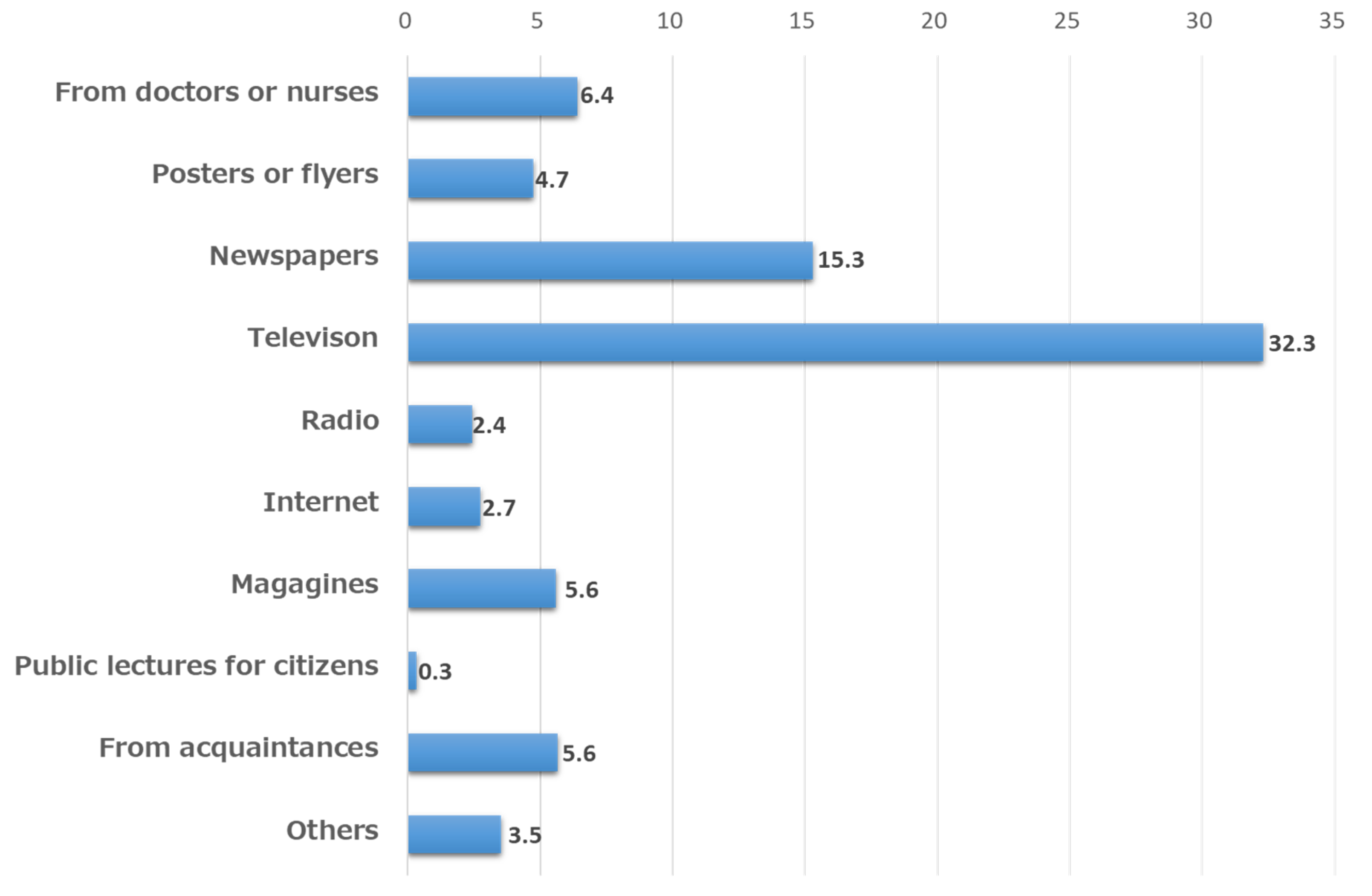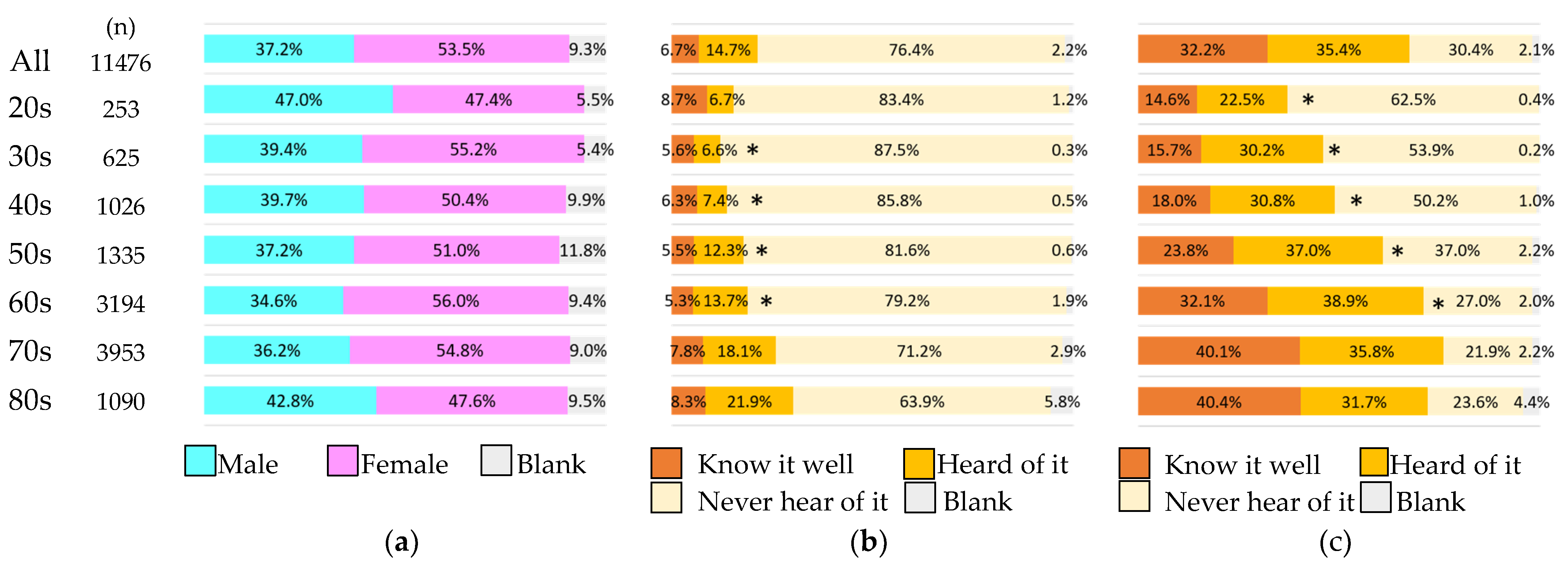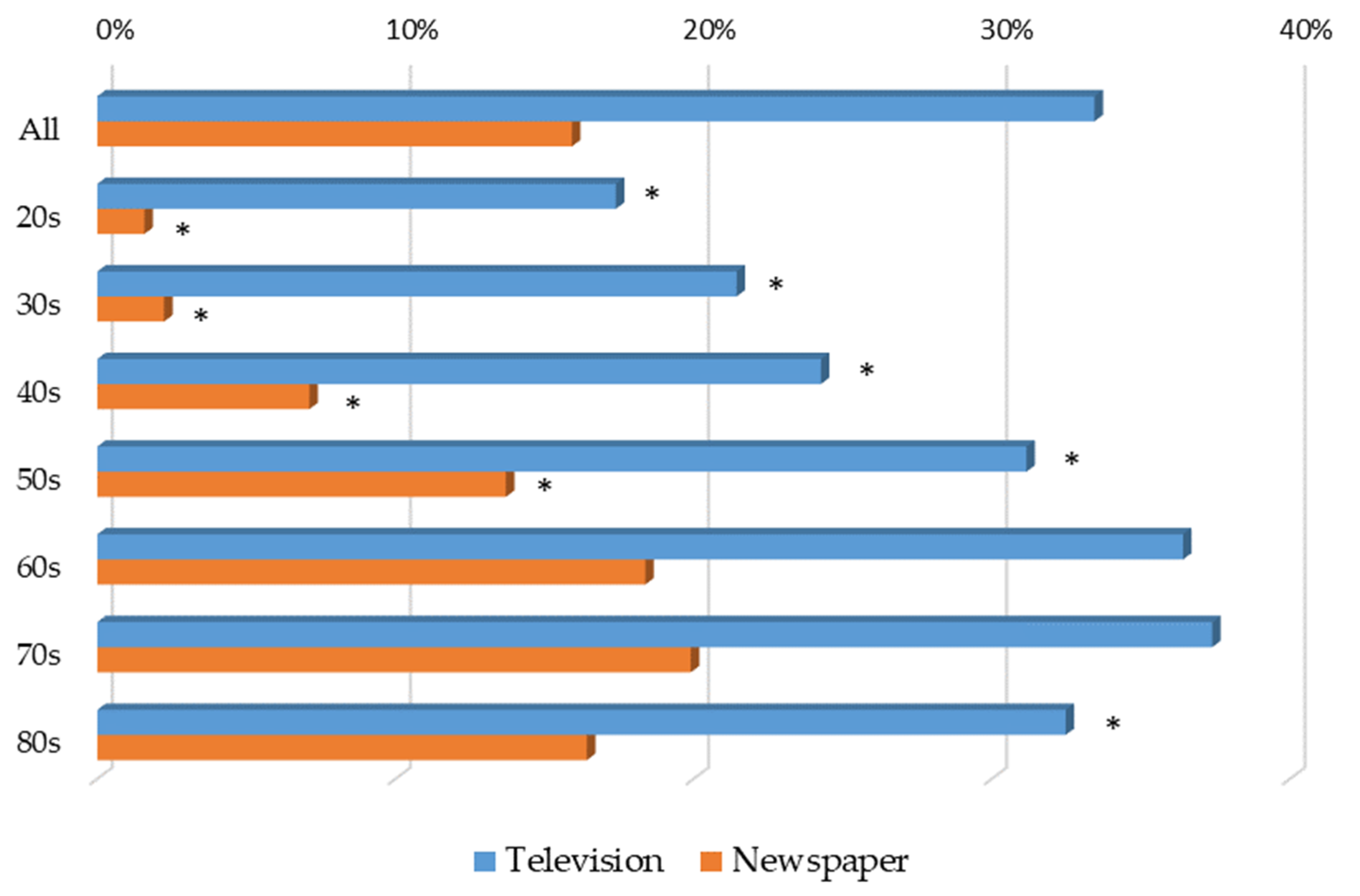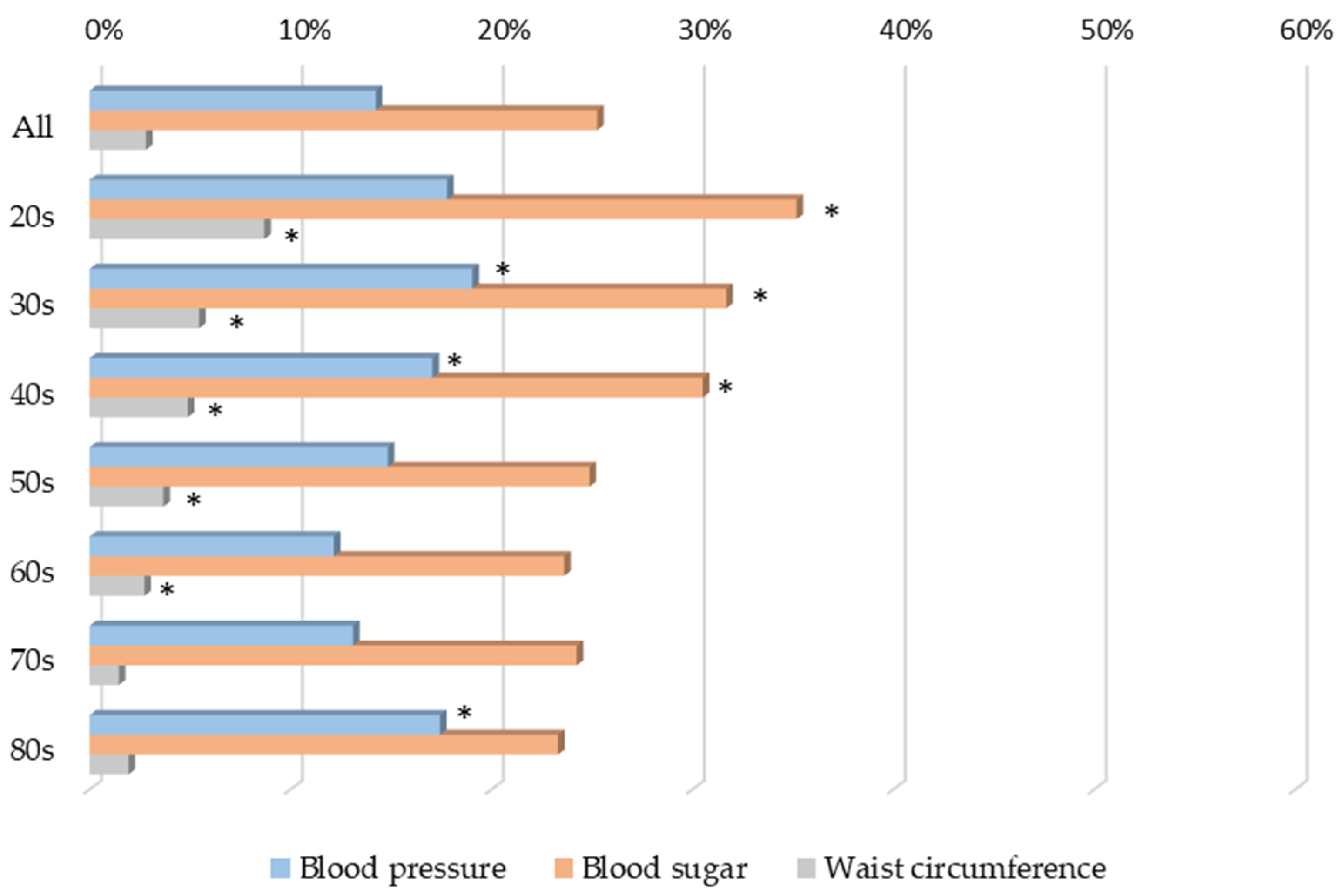Knowledge of Chronic Kidney Disease among the General Population: A Questionnaire Survey in Hokkaido Prefecture, Japan
Abstract
:1. Introduction
2. Materials and Methods
3. Results
3.1. Participants and Their Characteristics
3.2. Perception of CKD in the General Hokkaido Population
3.3. Understanding of the Diagnosis of CKD
3.4. Survey by Age Group on Knowledge of CKD
4. Discussion
5. Conclusions
Supplementary Materials
Author Contributions
Funding
Institutional Review Board Statement
Informed Consent Statement
Data Availability Statement
Acknowledgments
Conflicts of Interest
References
- Hanafusa, N.; Fukagawa, M. Global Dialysis Perspective: Japan. Kidney360 2020, 1, 416–419. [Google Scholar] [CrossRef] [PubMed] [Green Version]
- Nakagawa, N.; Sofue, T.; Kanda, E.; Nagasu, H.; Matsushita, K.; Nangaku, M.; Maruyama, S.; Wada, T.; Terada, Y.; Yamagata, K.; et al. J-CKD-DB: A nationwide multicentre electronic health record-based chronic kidney disease database in Japan. Sci. Rep. 2020, 10, 7351. [Google Scholar] [CrossRef] [PubMed]
- Masakane, I.; Nakai, S.; Ogata, S.; Kimata, N.; Hanafusa, N.; Hamano, T.; Wakai, K.; Wada, A.; Nitta, K. An Overview of Regular Dialysis Treatment in Japan (As of 31 December 2013). Ther. Apher. Dial. 2015, 19, 540–574. [Google Scholar] [CrossRef] [PubMed]
- Stenvinkel, P.; Heimburger, O.; Paultre, F.; Diczfalusy, U.; Wang, T.; Berglund, L.; Jogestrand, T. Strong association between malnutrition, inflammation, and atherosclerosis in chronic renal failure. Kidney Int. 1999, 55, 1899–1911. [Google Scholar] [CrossRef] [PubMed] [Green Version]
- Nakagawa, N.; Matsuki, M.; Yao, N.; Hirayama, T.; Ishida, H.; Kikuchi, K.; Hasebe, N. Impact of Metabolic Disturbances and Malnutrition-Inflammation on 6-Year Mortality in Japanese Patients Undergoing Hemodialysis. Ther. Apher. Dial. 2015, 19, 30–39. [Google Scholar] [CrossRef] [PubMed]
- Go, A.S.; Chertow, G.M.; Fan, D.J.; McCulloch, C.E.; Hsu, C.Y. Chronic kidney disease and the risks of death, cardiovascular events, and hospitalization. N. Engl. J. Med. 2004, 351, 1296–1305. [Google Scholar] [CrossRef] [PubMed]
- Maruyama, K.; Nakagawa, N.; Saito, E.; Matsuki, M.; Takehara, N.; Akasaka, K.; Sato, N.; Hasebe, N. Malnutrition, renal dysfunction and left ventricular hypertrophy synergistically increase the long-term incidence of cardiovascular events. Hypertens. Res. 2016, 39, 633–639. [Google Scholar] [CrossRef] [PubMed] [Green Version]
- Inker, L.A.; Astor, B.C.; Fox, C.H.; Isakova, T.; Lash, J.P.; Peralta, C.A.; Kurella Tamura, M.; Feldman, H.I. KDOQI US commentary on the 2012 KDIGO clinical practice guideline for the evaluation and management of CKD. Am. J. Kidney Dis. 2014, 63, 713–735. [Google Scholar] [CrossRef] [PubMed] [Green Version]
- Saijo, Y.; Utsugi, M.; Yoshioka, E.; Fukui, T.; Sata, F.; Nakagawa, N.; Hasebe, N.; Yoshida, T.; Kishi, R. Inflammation as a cardiovascular risk factor and pulse wave velocity as a marker of early-stage atherosclerosis in the Japanese population. Environ. Health Prev. Med. 2009, 14, 159–164. [Google Scholar] [CrossRef] [PubMed] [Green Version]
- Fukui, A.; Yokoo, T.; Nangaku, M.; Kashihara, N. New measures against chronic kidney diseases in Japan since 2018. Clin. Exp. Nephrol. 2019, 23, 1263–1271. [Google Scholar] [CrossRef] [PubMed]
- Sofue, T.; Hara, T.; Nishijima, Y.; Nishioka, S.; Watatani, H.; Yamanaka, M.; Takahashi, N.; Nishiyama, A.; Minamino, T.; Kagawa Association of Chronic Kidney Disease Initiatives. Changes in Prevalence and Health Checkup Coverage Rate of Chronic Kidney Disease (CKD) after Introduction of Prefecture-Wide CKD Initiative: Results of the Kagawa Association of CKD Initiatives. J. Pers. Med. 2021, 11, 1121. [Google Scholar] [CrossRef] [PubMed]
- Ito, T.; Kamei, F.; Sonoda, H.; Oba, M.; Kawanishi, M.; Yoshimura, R.; Fukunaga, S.; Egawa, M. Effectiveness of CKD Exacerbation Countermeasures in Izumo City. J. Pers. Med. 2021, 11, 1104. [Google Scholar] [CrossRef] [PubMed]
- Chow, K.M.; Szeto, C.C.; Kwan, B.; Leung, C.B.; Li, P.K. Public lacks knowledge on chronic kidney disease: Telephone survey. Hong Kong Med. J. 2014, 20, 139–144. [Google Scholar] [CrossRef] [PubMed]
- Almutary, H.H. Assessment of kidney disease knowledge among chronic kidney disease patients in the Kingdom of Saudi Arabia. J. Ren. Care 2021, 47, 96–102. [Google Scholar] [CrossRef] [PubMed]
- Tuot, D.S.; Wong, K.K.; Velasquez, A.; Crews, D.C.; Zonderman, A.B.; Evans, M.K.; Powe, N.R. CKD Awareness in the General Population: Performance of CKD-Specific Questions. Kidney Med. 2019, 1, 43–50. [Google Scholar] [CrossRef] [PubMed]







Publisher’s Note: MDPI stays neutral with regard to jurisdictional claims in published maps and institutional affiliations. |
© 2022 by the authors. Licensee MDPI, Basel, Switzerland. This article is an open access article distributed under the terms and conditions of the Creative Commons Attribution (CC BY) license (https://creativecommons.org/licenses/by/4.0/).
Share and Cite
Nakagawa, N.; Nishio, S. Knowledge of Chronic Kidney Disease among the General Population: A Questionnaire Survey in Hokkaido Prefecture, Japan. J. Pers. Med. 2022, 12, 1837. https://doi.org/10.3390/jpm12111837
Nakagawa N, Nishio S. Knowledge of Chronic Kidney Disease among the General Population: A Questionnaire Survey in Hokkaido Prefecture, Japan. Journal of Personalized Medicine. 2022; 12(11):1837. https://doi.org/10.3390/jpm12111837
Chicago/Turabian StyleNakagawa, Naoki, and Saori Nishio. 2022. "Knowledge of Chronic Kidney Disease among the General Population: A Questionnaire Survey in Hokkaido Prefecture, Japan" Journal of Personalized Medicine 12, no. 11: 1837. https://doi.org/10.3390/jpm12111837
APA StyleNakagawa, N., & Nishio, S. (2022). Knowledge of Chronic Kidney Disease among the General Population: A Questionnaire Survey in Hokkaido Prefecture, Japan. Journal of Personalized Medicine, 12(11), 1837. https://doi.org/10.3390/jpm12111837






